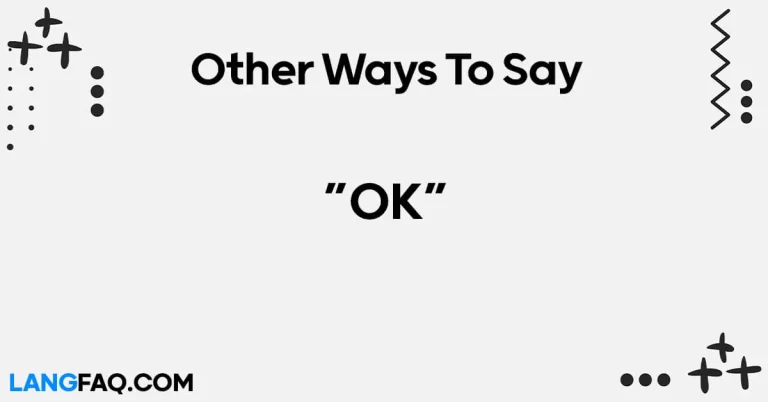In the fast-paced world of communication, clarity is key. “For Your Information” or “FYI” has been a staple in conveying details, but variety is the spice of effective expression. This article unveils 12 alternative ways to say “FYI,” providing insights into the art of communication and how it evolves across various contexts.
12 Other Ways to Say “FYI”
Here are 12 other ways to say “FYI”:
- For Your Information
- Just a Quick Note
- Noted
- Thought You Should Know
- Important Update
- In Case You Missed It (ICYMI)
- For Your Consideration
- Bringing to Your Attention
- Just a Heads Up
- Sharing the Scoop
- Gentle Reminder
- Letting You In On It
Here’s a table with meanings and examples for the 12 other ways to say “FYI”:
| Expression | Meaning | Example |
|---|---|---|
| For Your Information | Providing information for awareness | “FYI, the meeting has been rescheduled.” |
| Just a Quick Note | A brief message or update | “Just a quick note: we’ll meet at 3 PM.” |
| Noted | Acknowledging receipt of information | “Your feedback has been noted. Thank you.” |
| Thought You Should Know | Informing someone of important details | “Thought you should know about the change.” |
| Important Update | Signifying a crucial or noteworthy update | “An important update: new policies in place.” |
| In Case You Missed It (ICYMI) | Highlighting information that might be missed | “ICYMI: The deadline is extended to Friday.” |
| For Your Consideration | Suggesting something for one’s consideration | “For your consideration, here’s a proposal.” |
| Bringing to Your Attention | Drawing focus to specific information | “Bringing to your attention: new guidelines.” |
| Just a Heads Up | Giving advance notice or alert | “Just a heads up, the system will be down.” |
| Sharing the Scoop | Sharing the latest or exclusive information | “Sharing the scoop on our upcoming project.” |
| Gentle Reminder | Offering a polite reminder | “Gentle reminder: submit your reports by Friday.” |
| Letting You In On It | Sharing insider information or details | “Letting you in on it: exciting news ahead.” |
Expanding your vocabulary with these alternatives to “FYI” allows you to communicate more effectively and tailor your messages to different situations. Each expression brings its own nuance, providing versatility in conveying information in both personal and professional settings.
Is It Correct to Say “FYI”?
Absolutely! “FYI” is a widely accepted and commonly used abbreviation that stands for “For Your Information.” It’s a quick and efficient way to inform someone that the following information is intended for their awareness.
When to Use “FYI”:
- Informal Communication: In emails, text messages, or chat conversations, especially when conveying non-urgent or supplementary information.
- Professional Settings: In the workplace, “FYI” is often used in emails or memos to share updates, reminders, or additional details without the need for an immediate response.
- Documentation: When leaving notes or comments on documents, reports, or files, “FYI” is a succinct way to indicate that the information is provided for reference.
Example Usage:
- Email Subject: New Procedure FYI Hi [Recipient’s Name],We’ve implemented a new procedure for expense reports, FYI. Please take a moment to review the updated guidelines.Best, [Your Name]
Variations:
- Colleague to Colleague: “Hey, quick heads up—FYI, the project meeting got rescheduled to 3 PM.”
- Manager to Team: “Team, FYI, the client presentation has been postponed to next week. Please adjust your schedules accordingly.”
Grammar/Usage Tips:
- Clarity: Use “FYI” when the information is supplementary or additional, ensuring the recipient understands its non-urgent nature.
- Formality: While widely accepted in professional settings, consider the context. In more formal documents, the full phrase “For Your Information” may be preferable.
- Email Subject Line: Using “FYI” in the subject line of an email provides a quick preview of the content, allowing recipients to prioritize their attention.
Professional Mail Example With “FYI”
Subject: Important Update on Project Timeline FYI
Dear [Recipient’s Name],
I trust this message finds you well. I wanted to provide you with an FYI regarding a crucial update on the project timeline.
FYI, based on the recent assessment of our progress, we’ve decided to extend the deadline by one week. This adjustment is aimed at ensuring the highest quality deliverables and allowing our team the necessary time for thorough reviews.
We believe that this extension will not only enhance the overall quality of our work but also contribute to a more seamless and successful project outcome.
For your convenience, I’ve attached a revised project schedule outlining the adjusted milestones. Please take a moment to review the document, and feel free to reach out if you have any questions or require further clarification.
Your cooperation and understanding during this adjustment period are greatly appreciated. We are confident that this decision will result in an even more successful project outcome.
Thank you for your attention to this matter.
Best regards,
[Your Full Name] [Your Position] [Your Company] [Your Contact Information]
Just a Quick Note: A Brief Message with Impact
In the fast-paced world of communication, there are moments when brevity is key. “Just a Quick Note” serves as a versatile alternative to “FYI,” especially when you need to convey information concisely. This phrase is suitable for various contexts, both formal and informal.
When to Use:
- Formal Context: In professional emails or business memos, a quick note can efficiently deliver important updates or reminders.
- Informal Context: Among friends or colleagues, a casual text or chat can include a quick note for a more relaxed vibe.
Example:
Email Subject: Project Deadline Extension
Hey [Colleague’s Name],
Just a quick note to inform you that the project deadline has been extended to [New Deadline]. Your input is crucial, and we appreciate your dedication.
Best regards, [Your Name]
Variations:
- Colleague to Colleague: “Just a Heads Up: We have a team meeting at 2 PM.”
- Mentor to Mentee: “Quick Note: Consider exploring the new software for our next project.”
Dictionary Insight:
According to Cambridge Dictionary, a “quick note” is a short, informal message or letter.
Pros and Cons:
Pros:
- Efficiency: Conveys information swiftly.
- Versatility: Applicable in various settings.
Cons:
- Informality: May be perceived as too casual in certain professional settings.
Grammar/Usage Tip:
Ensure clarity in your quick notes by stating the main point concisely. Avoid unnecessary details that might dilute the message.
Noted: Acknowledging Information Professionally
In the realm of professional communication, acknowledging receipt of information is crucial. “Noted” is a succinct way to confirm that the message has been received and understood. Let’s explore when and how to use this alternative effectively.
When to Use:
- Formal Context: In response to emails or directives from higher-ups, “Noted” demonstrates professionalism.
- Informal Context: Among colleagues, it can be used in a more casual yet respectful manner.
Example:
Email Reply: Meeting Agenda
Hi [Sender’s Name],
Noted. Looking forward to discussing the agenda items in the upcoming meeting.
Best, [Your Name]
Variations:
- Colleague to Colleague: “Noted with thanks. Let’s catch up during lunch.”
- Supervisor to Team Member: “Noted your concerns. We’ll address them in the next team meeting.”
Dictionary Insight:
Cambridge Dictionary defines “noted” as officially recorded or known.
Pros and Cons:
Pros:
- Professionalism: Conveys acknowledgment without unnecessary elaboration.
- Efficiency: Saves time in communication.
Cons:
- Potential Coldness: May come across as too brief in certain interpersonal contexts.
Grammar/Usage Tip:
When using “Noted” in emails, consider adding a brief positive statement to maintain a friendly tone.
Thought You Should Know: Navigating the Terrain of Considerate Communication
In the landscape of communication, expressing thoughtfulness is essential. “Thought You Should Know” adds a touch of consideration, signaling that the information is deemed important for the recipient. This phrase is suitable for a variety of situations, striking a balance between formality and familiarity.
When to Use:
- Formal Context: In professional settings, this phrase can be employed to convey significant updates or changes.
- Informal Context: Among friends or close colleagues, it serves as a considerate way to share personal or professional insights.
Example:
Email Subject: Schedule Adjustment
Hi [Recipient’s Name],
Hope this email finds you well. Thought you should know that the project timeline has been adjusted to accommodate unforeseen challenges. Your adaptability is much appreciated.
Best regards, [Your Name]
Variations:
- Friend to Friend: “Thought you should know, the concert got rescheduled to next week.”
- Manager to Team: “Team, thought you should know about the new client feedback. Let’s discuss in our meeting.”
Dictionary Insight:
According to Cambridge Dictionary, “thought” refers to the product of mental activity, and “know” means to be aware of facts or information.
Pros and Cons:
Pros:
- Consideration: Communicates a sense of thoughtfulness.
- Versatility: Applicable in both professional and personal spheres.
Cons:
- Subjectivity: The importance of the information might vary from person to person.
Grammar/Usage Tip:
When using “Thought You Should Know,” be specific about the information you’re sharing to ensure clarity and relevance.
Important Update: Signifying Significance with Precision
When an update carries substantial weight, “Important Update” steps into the limelight. This alternative to “FYI” emphasizes the gravity of the information being shared, making it suitable for various formal and professional scenarios.
When to Use:
- Formal Context: In business communications, especially when disseminating critical updates or policy changes.
- Informal Context: Among peers, especially when the shared information is vital for the group.
Example:
Email Subject: Urgent – Policy Changes
Dear [Team],
An important update regarding our company policies requires your immediate attention. Please review the attached document by [Deadline].
Best regards, [Your Name]
Variations:
- Supervisor to Team: “Team, an important update on the project deadline. Let’s discuss in tomorrow’s meeting.”
- Parent to Child: “Hey, important update! We’re planning a family vacation next month.”
Dictionary Insight:
Cambridge Dictionary defines “important” as having great effect or influence.
Pros and Cons:
Pros:
- Clarity: Directly conveys the significance of the information.
- Urgency: Implies the need for immediate attention.
Cons:
- Potentially Intense: May be perceived as alarming in less formal contexts.
Grammar/Usage Tip:
Pair “Important Update” with a clear and concise summary of the information to maintain a balance between urgency and clarity.
In Case You Missed It (ICYMI): Ensuring No One is Left Uninformed
In the era of information overload, ensuring that essential updates don’t go unnoticed is vital. “In Case You Missed It (ICYMI)” offers a friendly nudge, especially useful in environments where staying updated is crucial.
When to Use:
- Formal Context: In corporate emails or newsletters, ensuring that team members are aware of recent developments.
- Informal Context: Among friends or colleagues, ICYMI can be used to share interesting news or events.
Example:
Email Subject: Weekly Recap – ICYMI
Hi [Recipient’s Name],
In case you missed it, here’s a quick recap of this week’s highlights. Don’t forget our team meeting tomorrow at 10 AM.
Cheers, [Your Name]
Variations:
- Friend to Friend: “ICYMI, the new episode of our favorite show is out. Let’s binge-watch this weekend!”
- Project Manager to Team: “ICYMI, we achieved a significant milestone in the project. Kudos to the entire team!”
Dictionary Insight:
The abbreviation “ICYMI” stands for “In Case You Missed It,” indicating that the information is shared for those who might have overlooked it.
Pros and Cons:
Pros:
- Inclusivity: Ensures everyone is on the same page.
- Engagement: Encourages people to catch up on important updates.
Cons:
- Assumption: Assumes that the recipient might not be aware, which may not always be the case.
Grammar/Usage Tip:
Use ICYMI sparingly and reserve it for genuinely important or interesting information to maintain its impact.
For Your Consideration: Inviting Thoughtful Reflection
When aiming for a more formal tone, especially in professional or business communications, “For Your Consideration” is a phrase that invites reflection and thoughtful consideration. Let’s explore when and how to use this expression effectively.
When to Use:
- Formal Context: In emails, proposals, or reports where a decision or thoughtful input is sought.
- Informal Context: In more serious conversations among colleagues or friends seeking thoughtful opinions.
Example:
Email Subject: Proposal for New Initiatives – For Your Consideration
Dear [Recipient’s Name],
I am pleased to present the proposal for the upcoming initiatives. For your consideration, please review the attached document, and feel free to share your insights by [Deadline].
Best regards, [Your Name]
Variations:
- Manager to Team: “Team, the new project proposal is out. For your consideration, let’s gather for a discussion next week.”
- Friend to Friend: “For your consideration, which movie do you think we should watch for our movie night?”
Dictionary Insight:
Cambridge Dictionary defines “consideration” as careful thought, especially before making a decision or judgment.
Pros and Cons:
Pros:
- Politeness: Adds a polite touch when seeking input or feedback.
- Professionalism: Suitable for formal communication.
Cons:
- Formality: Might come across as too formal in casual settings.
Grammar/Usage Tip:
Use “For Your Consideration” when you genuinely value the input of the recipient, ensuring a respectful tone in your communication.
Bringing to Your Attention: Focused Communication in Professional Settings
In the corporate realm, precision and clarity are paramount. “Bringing to Your Attention” is a phrase that commands focus, especially in formal environments where conveying information with directness is crucial.
When to Use:
- Formal Context: In business emails, reports, or meetings where specific details require the recipient’s attention.
- Informal Context: Among colleagues or team members when highlighting critical information.
Example:
Email Subject: Regulatory Update – Bringing to Your Attention
Dear [Recipient’s Name],
Bringing to your attention the recent regulatory changes affecting our industry. Please review the attached document for a comprehensive overview.
Best regards, [Your Name]
Variations:
- Supervisor to Team: “Team, bringing to your attention the client feedback. Let’s strategize for improvements.”
- Friend to Friend: “Bringing to your attention the new restaurant in town. Shall we check it out this weekend?”
Dictionary Insight:
The phrase “bringing to your attention” is an idiomatic expression signifying the act of making someone aware of something.
Pros and Cons:
Pros:
- Clarity: Clearly signals the importance of the information.
- Professionalism: Maintains a formal and business-appropriate tone.
Cons:
- Directness: Might come across as too formal in casual or personal settings.
Grammar/Usage Tip:
Pair “Bringing to Your Attention” with a brief and well-structured summary to ensure the recipient grasps the key points efficiently.
Just a Heads Up: Friendly Alerts for Smooth Collaboration
In the realm of friendly and informal communication, “Just a Heads Up” offers a casual yet effective way to alert others about impending developments. It’s a versatile phrase suitable for both professional and personal scenarios.
When to Use:
- Formal Context: In workplace communications, especially when providing friendly reminders or pre-informing about changes.
- Informal Context: Among friends or peers, especially when a casual tone is appropriate.
Example:
Email Subject: Upcoming Team Building Event – Just a Heads Up
Hey [Team],
Just a heads up, we’re planning a team-building event next month. Stay tuned for more details!
Cheers, [Your Name]
Variations:
- Colleague to Colleague: “Just a heads up, the client will be visiting our office tomorrow.”
- Friend to Friend: “Just a heads up, I’ll be running a bit late for dinner tonight.”
Dictionary Insight:
The phrase “just a heads up” is an idiomatic expression, indicating a friendly alert or advance notice.
Pros and Cons:
Pros:
- Friendliness: Adds a friendly touch to communication.
- Versatility: Fits well in various informal settings.
Cons:
- Informality: May be perceived as too casual in certain professional contexts.
Grammar/Usage Tip:
Use “Just a Heads Up” when the information you’re sharing is meant to facilitate smooth collaboration or prevent surprises.
Sharing the Scoop: Infusing Informality with a Dash of Excitement
In casual and friendly conversations, injecting a bit of flair can make communication more engaging. “Sharing the Scoop” is a lighthearted way to convey information, especially when the tone is informal and conversational.
When to Use:
- Formal Context: In workplaces with a relaxed culture, or when delivering updates that embrace a conversational tone.
- Informal Context: Among friends or close colleagues when sharing exciting or interesting news.
Example:
Email Subject: Big News – Sharing the Scoop!
Hi [Recipient’s Name],
Exciting news—I couldn’t wait to share the scoop! Our project just got the green light. Let’s celebrate in tomorrow’s meeting!
Cheers, [Your Name]
Variations:
- Colleague to Colleague: “Sharing the scoop: the office is getting a makeover. Get ready for a fresh look!”
- Friend to Friend: “Guess what? I’m sharing the scoop about our upcoming road trip. Are you in?”
Dictionary Insight:
“Sharing the scoop” is an idiomatic expression, using “scoop” to refer to exclusive or exciting news.
Pros and Cons:
Pros:
- Engagement: Grabs attention with an informal and conversational tone.
- Excitement: Adds a sense of enthusiasm to the shared information.
Cons:
- Informality: May not be suitable for strictly formal or professional communications.
Grammar/Usage Tip:
Use “Sharing the Scoop” when you want to convey information with an element of excitement and create a positive and engaging atmosphere.
Gentle Reminder: Polite Nudges for Time-Sensitive Matters
In the realm of professional etiquette, providing gentle reminders is a courteous way to ensure that important tasks are not overlooked. “Gentle Reminder” is a phrase that combines politeness with a subtle prompt.
When to Use:
- Formal Context: In professional emails or communications where a gentle nudge is required for time-sensitive matters.
- Informal Context: Among colleagues or team members when a friendly reminder is appropriate.
Example:
Email Subject: Friendly Reminder – Monthly Report Due Soon
Dear [Recipient’s Name],
A gentle reminder that the monthly report is due by [Deadline]. Your timely submission is greatly appreciated.
Best regards, [Your Name]
Variations:
- Supervisor to Team: “Gentle reminder: our team meeting is scheduled for 2 PM today. Looking forward to your insights.”
- Friend to Friend: “Hey, gentle reminder about our movie night tonight. Don’t forget the popcorn!”
Dictionary Insight:
The phrase “gentle reminder” combines “reminder” (a prompt to remember) with “gentle” (mild and considerate).
Pros and Cons:
Pros:
- Politeness: Maintains a courteous tone, even when nudging for action.
- Effectiveness: Prompts without being overly assertive.
Cons:
- Potential Redundancy: Overuse may diminish the impact over time.
Grammar/Usage Tip:
Pair “Gentle Reminder” with clear and actionable details to ensure the recipient understands the specific task or deadline being referenced.
Letting You In On It: Sharing Insider Information with a Personal Touch
In certain situations, conveying information with a touch of personal connection can enhance the recipient’s engagement. “Letting You In On It” is an informal yet inclusive phrase that suggests sharing exclusive or behind-the-scenes details.
When to Use:
- Formal Context: In workplaces with a more relaxed culture, or when delivering updates that benefit from a personal touch.
- Informal Context: Among friends or colleagues when sharing personal or exciting news.
Example:
Email Subject: Letting You In On It – Exciting News!
Hi [Recipient’s Name],
I couldn’t wait to tell you—I’m letting you in on it! We just secured a major client. Let’s discuss the details over coffee soon.
Cheers, [Your Name]
Variations:
- Colleague to Colleague: “Letting you in on it: our team is planning a surprise for the upcoming office party.”
- Friend to Friend: “Guess what? I’m letting you in on the plan for the weekend getaway. Get ready for an adventure!”
Dictionary Insight:
The phrase “letting you in on it” implies the act of sharing confidential or exclusive information with someone.
Pros and Cons:
Pros:
- Inclusivity: Creates a sense of camaraderie by sharing information in a personal manner.
- Engagement: Encourages the recipient to feel more connected to the shared news.
Cons:
- Informality: May not be suitable for strictly formal or professional communications.
Grammar/Usage Tip:
Use “Letting You In On It” when you want to convey information with a personal touch, building a stronger connection with the recipient.
FYI, Just Sharing: Casual Information Sharing for Everyday Conversations
In the world of casual communication, especially in social settings or friendly exchanges, “FYI, Just Sharing” is a versatile phrase that combines the informality of “FYI” with the friendly tone of “Just Sharing.”
When to Use:
- Formal Context: In workplaces with a relaxed culture or when sharing updates that embrace a more casual tone.
- Informal Context: Among friends or colleagues when sharing everyday information.
Example:
Email Subject: FYI, Just Sharing – Quick Office Update
Hey [Team],
FYI, just sharing a quick office update. We’re rearranging the workspace for a fresh vibe. Let me know your thoughts!
Cheers, [Your Name]
Variations:
- Friend to Friend: “FYI, just sharing: I tried a new recipe last night, and it was amazing! Let me know if you want it.”
- Colleague to Colleague: “FYI, just sharing some insights from the recent industry webinar. Worth a watch.”
Dictionary Insight:
The abbreviation “FYI” stands for “For Your Information,” and “just sharing” emphasizes the act of casually disseminating information.
Pros and Cons:
Pros:
- Informality: Perfect for casual and friendly conversations.
- Clarity: Conveys information in a straightforward yet approachable manner.
Cons:
- Potential Overuse: In more formal settings, overusing this phrase might dilute its impact.
Grammar/Usage Tip:
Use “FYI, Just Sharing” when you want to share information in an easygoing manner, suitable for both professional and personal conversations.
FAQs
Q: Can I use these alternatives interchangeably in professional settings? Absolutely! While some alternatives may lean towards formality, most can be adapted to various professional contexts, ensuring versatility in your communication style.
Q: Are these alternatives suitable for both written and spoken communication? Certainly! Whether you’re crafting an email, engaging in a meeting, or having a casual conversation, these alternatives seamlessly integrate into both written and spoken communication.
Q: How do I choose the right alternative for a specific situation? Consider the tone, formality, and context of your message. For formal documents, opt for polished alternatives, while casual conversations allow for a more relaxed choice.
Q: Can these alternatives be used in international communication? Absolutely! These alternatives provide a universal appeal, making them suitable for international communication and fostering effective cross-cultural understanding.
Q: Are there any alternatives that convey urgency or importance? Certainly! Expressions like “Urgent Update” or “Time-Sensitive” can effectively convey urgency, ensuring your message receives the attention it deserves.
Q: Will using these alternatives improve my communication skills? Absolutely! Expanding your repertoire of expressions enhances your ability to tailor messages to specific situations, showcasing your communication prowess.
Conclusion
Mastering the art of communication involves adapting to diverse situations. By exploring “12 Other Ways to Say ‘FYI’,” you’ve taken a step towards becoming a more effective communicator. Remember, the key lies in choosing the right expression for the right moment.







